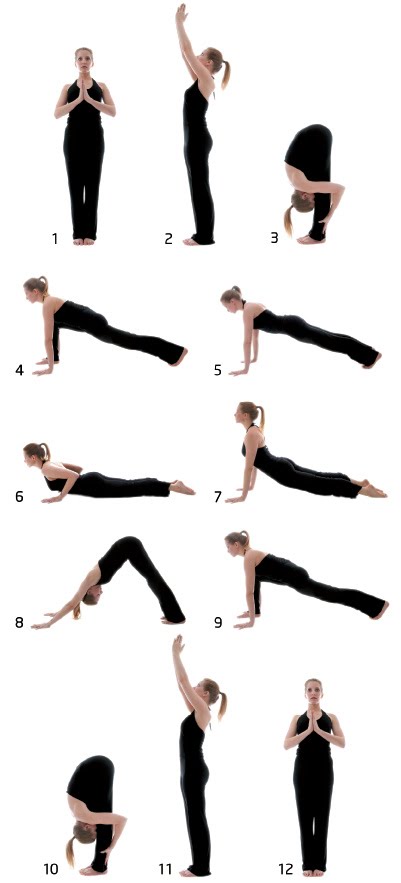Name
Sun Salutation, Sun Salute, Salutation to the Sun, etc., (all are translations of the original Sanskrit sūrya namaskāra)
Purpose/Effects
The Sun Salutation consists of sequence of 12 postures, each flowing smoothly into the next. It is the most basic sequence of postures in most hatha yoga traditions. Among the many claimed physical and emotional effects of this exercise are increased strength and flexibility in the spine, and body in general. It can be used as a warm up for other exercises, as a way to stretch before sitting in meditation, or when repeated as a full workout in itself.
Method
Do these 12 postures in order:

Long Version
Breathing is very important in Sun Salutations, so we will note the inhales and exhales here, along with each pose.
Begin by standing straight in a with your feet together.
- Bring your arms up into a prayer pose.
- Inhale, bringing your arms together above your head.
- Exhale, bending at your hips. Bring your head down to your shins (or as far as you can without straining).
- Inhale, bringing your back half-way up so that it is flat, like a table. Look forward. (not pictured)
Then bring your right foot forward in a long lunge, placing your palms flat on the floor.
- Exhale, placing your right foot back with your left, as if you are doing a pushup.
Here is a video that teaches the basic Sun Salutation:
History
Sun Salutations can be found in the Indian Vedas, which are the oldest spiritual scriptures known. The Vedas praise Sun Salutations as a way to enhance health and wellbeing. Eventually the idea of Sun Salutations became part of the daily practice required of devout Hindus. The exact method of these ancient Sun Salutations is unknown, and varied greatly from place to place, but one main aspect was physical prostration. The specific sequence of exercises in the modern Sun Salutation was created by Shrimant Bhavanrao Pant Pratinidhi (1868 - 1951), but the basic concept and practice is extremely old.
Cautions
Obviously, the basic Sun Salutation should not be attempted by anyone with a medical problem or physical disability which would make the practice dangerous or overly strenuous. There are modified versions of the practice appropriate for people with almost any condition.
Notes
Variations
- There are a tremendous number of variations to the basic Sun Salutation exercise. There are ways to do it that make it much easier and can be performed by the elderly, infirmed, or very young chiildren. Alternately there are variations intended to challenge even advanced practitioners. Beyond these degrees of difficulty, there are also numerous variations that emphasize various aspects of the practice. The basic exercise described above is just the most common, basic version.
Mantras
- Using Mantra (the repetition of sacred words or phrases) is a standard practice in Hindu (and some Buddhist) tradition. Because the ancient Vedic scriptures contain numerous hymns to the sun, these sacred texts have been incorporated into the Sun Salutation practice. These mantras are thought to increase mental focus, and to the devout they are thought to bring the literal blessings of the sun or soul. In this way of doing things, each posture of the Sun Salutation has its own mantra to be repeated once while in that posture. Like the Sun Salutation practice itself, there are a large number of variations to this additional mantra practice. A fairly standard version follows:
Posture 1. om mitrāya namaḥ
Posture 2. om ravaye namaḥ
Posture 3. om sūryāya namaḥ
Posture 4. om bhānave namaḥ
Posture 5. om khagāya namaḥ
Posture 6. om puṣṇe namaḥ
Posture 7. om hiraṇya garbhāya namaḥ
Posture 8. om marīcaye namaḥ
Posture 9. om ādityāya namaḥ
Posture 10. om savitre namaḥ
Posture 11. om arkāya namaḥ
Posture 12. om bhāskarāya namaḥ
As mentioned above, these can be varied or added to in many ways, including the use of extra "seed" mantras, special breathing exercises (pranayama), and visualizations.
Is This an Exercise or a Spiritual Practice?
- In short, it can be either, depending on how you want to do it. Simply doing Sun Salutations as a physical exericise will greatly increase your physical strength and flexibility. Because it originates from a spiritual context, however, it can also be used to increase mental focus, and contribute to a sense of devotion, gratitude, and blessedness. It all depends on your viewpoint, goals, and desires for the practice.
See Also
